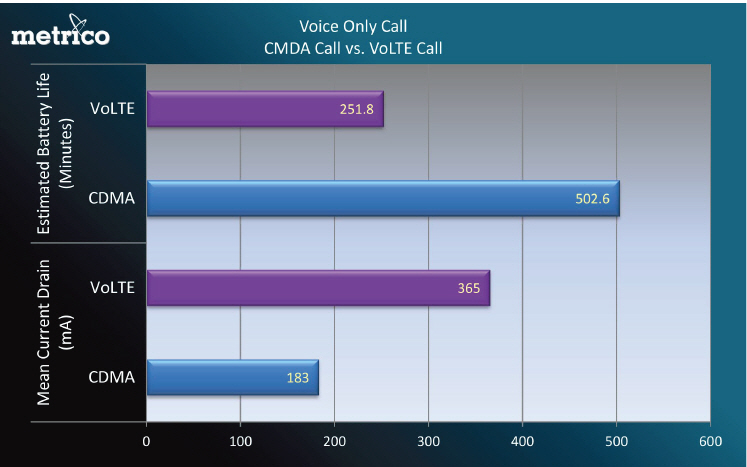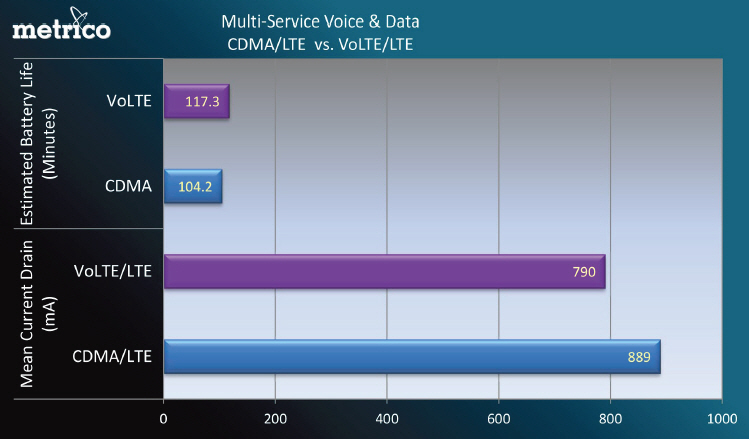Recently, Spirent (formerly Metrico Wireless), a vendor focused on delivering mobile device performance information to wireless carriers, device OEMs and corporate enterprises, conducted a study on the impact of IP-based Voice over LTE (VoLTE) on the battery life of smartphones.
The results, to be released in a new industry report, strongly suggest VoLTE will not make users happy campers when making voice calls. VoLTE can reduce battery life by up to 50 percent.
MetroPCS is one of the only carriers we are aware of that has launched VoLTE. AT&T expects to launch VoLTE some time in 2013, and Verizon will probably follow suit later in 2013 with initial trials, with the expectation of a launch in early 2014.
General LTE Battery Issues
The issue of LTE mobile device battery life is an interesting one, generally speaking. LTE itself is really no more power hungry than any of today's current crop of non-LTE smartphones, but that is not quite the reputation LTE phones have grabbed for themselves.
So, why then have LTE phones been labeled as destroyers of battery life? There are two different reasons, depending on which type of network you are connected to.
Let's take Verizon's, which is currently the champ in terms of availability. Due to the underlying design of Verizon's CDMA2000-based 3G network, Verizon must force its LTE phones to stay in dual 3G/LTE network mode operation at all times – that is, Verizon phones must always run both radios at all times, so that its LTE-enabled phones essentially consume twice the power.
Aesthetically, that’s an ugly solution, but until LTE is pervasive and CDMA2000 is fully phased out, it isn't going to change. LTE phones on Verizon's networks will need to rely on new battery technologies to overcome this issue.
Things are a bit different on the AT&T LTE network front. Its LTE-enabled smartphones operate in what is called passive mode, and its GSM-based network does not require AT&T phones to operate in always-on dual mode, as Verizon's phones must do.
One would think that this would prove to be an advantage for AT&T but for the immediate future AT&T's LTE phone battery life suffers from different technical reasons. For example, AT&T's LTE deployments, for example, do not always produce robust LTE signals, which in turn requires AT&T's LTE phones to use much more power to stay connected, in turn draining battery power.
This LTE battery issue is the reason why Apple did not introduce LTE with the iPhone 4/4S. The new iPhone 5 and LTE-enabled iPads have the latest in LTE modems, which Apple has further tweaked through its designs to enable the devices – at least on the data end of things – to provide adequate daily battery life.
The Spirent Findings
There is another major question that comes up here. Is there a difference in terms of battery usage when making voice calls the old fashioned way (traditional circuit-switched) as opposed to using IP-based VoLTE? To find out, Spirent ran a test across two different markets utilizing an unnamed wireless service provider's networks.
Current drain and power consumption samples were collected at multiple locations in each market for CDMA and VoLTE calls, as well as simultaneous multi-service CDMA/LTE and VoLTE/LTE voice and data calls. The mean value of respective samples was used to determine battery life estimations.
The battery profile of the mobile test device was as follows:
- Fully Charged Volts: 3.7V
- Battery Capacity (mAh): 1540
- Battery Type: Li-ion
In each market, tests were performed at two separate locations with RF signal strength of approximately -75 dB. Tests were performed in a CDMA market and an LTE market.
So let's get right down to the details of the findings, which are summarized in the chart shown below for direct call-only tests:

That is a rather jaw-dropping comparison to say the least. VoLTE simply cannot compete at this point in time. Sales people on the road who still use their phones a great deal – and the companies they work for – should be concerned.
The next set of tests involved a multi-service scenario, coupling voice calls with data services. Here, the scenario actually changes significantly. Though VoLTE still ends up trailing on call time, as shown in the chart below, the variances are markedly different from voice-only services. This is at least much better news, as the combined voice/data services are probably more representative of how most people will use their smartphones.

Ardeshir Ghanbarzadeh, director of services development at Spirent and the author of the report, notes the following: "The results of the study demonstrate that when the device is tested for a voice call, there is approximately a 100-percent increase in current drain for a VoLTE call compared to a CDMA call, translating to a 50-percent reduction in talk-time battery life. In the case of this device, the battery life on the voice only call decreased from an estimated 503 minutes to 252 minutes."
Ghanbarzadeh concludes, "The significant difference in current drain between VoLTE and CDMA technologies for voice calling applications suggests further optimization of devices supporting VoLTE calls are needed in order to give end-users talk-time battery life expectancy levels similar to that of 3G devices."
Quite honestly, the results of these tests are not what we would have guessed would be the case. It appears the wireless service providers and their LTE mobile device partners have some work to do ahead of their launches.
Edited by
Braden Becker  QUICK LINKS
QUICK LINKS